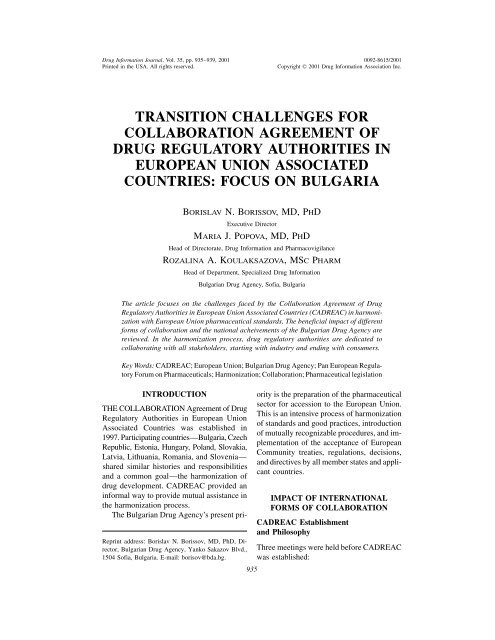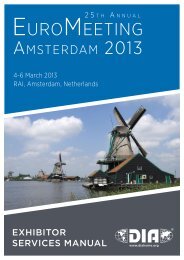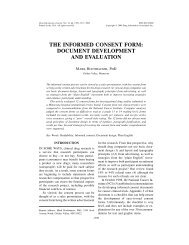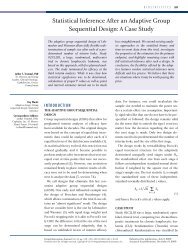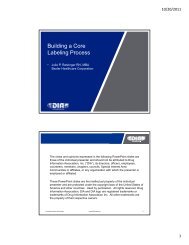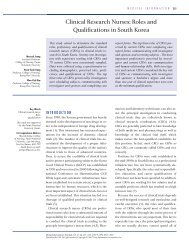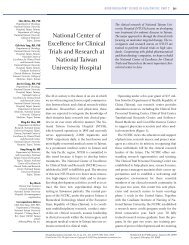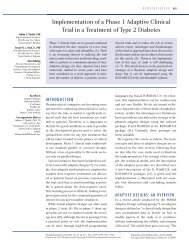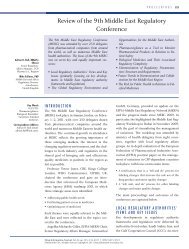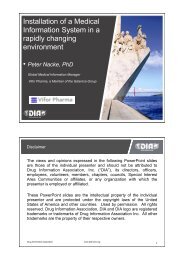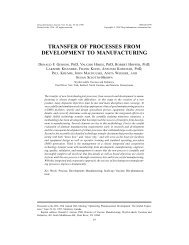transition challenges for collaboration agreement of drug regulatory ...
transition challenges for collaboration agreement of drug regulatory ...
transition challenges for collaboration agreement of drug regulatory ...
You also want an ePaper? Increase the reach of your titles
YUMPU automatically turns print PDFs into web optimized ePapers that Google loves.
Drug In<strong>for</strong>mation Journal, Vol. 35, pp. 935–939, 2001 0092-8615/2001<br />
Printed in the USA. All rights reserved. Copyright © 2001 Drug In<strong>for</strong>mation Association Inc.<br />
TRANSITION CHALLENGES FOR<br />
COLLABORATION AGREEMENT OF<br />
DRUG REGULATORY AUTHORITIES IN<br />
EUROPEAN UNION ASSOCIATED<br />
COUNTRIES: FOCUS ON BULGARIA<br />
BORISLAV N. BORISSOV, MD,PHD<br />
Executive Director<br />
MARIA J. POPOVA, MD, PHD<br />
Head <strong>of</strong> Directorate, Drug In<strong>for</strong>mation and Pharmacovigilance<br />
ROZALINA A. KOULAKSAZOVA, MSC PHARM<br />
Head <strong>of</strong> Department, Specialized Drug In<strong>for</strong>mation<br />
Bulgarian Drug Agency, S<strong>of</strong>ia, Bulgaria<br />
The article focuses on the <strong>challenges</strong> faced by the Collaboration Agreement <strong>of</strong> Drug<br />
Regulatory Authorities in European Union Associated Countries (CADREAC) in harmonization<br />
with European Union pharmaceutical standards. The beneficial impact <strong>of</strong> different<br />
<strong>for</strong>ms <strong>of</strong> <strong>collaboration</strong> and the national acheivements <strong>of</strong> the Bulgarian Drug Agency are<br />
reviewed. In the harmonization process, <strong>drug</strong> <strong>regulatory</strong> authorities are dedicated to<br />
collaborating with all stakeholders, starting with industry and ending with consumers.<br />
Key Words: CADREAC; European Union; Bulgarian Drug Agency; Pan European Regulatory<br />
Forum on Pharmaceuticals; Harmonization; Collaboration; Pharmaceutical legislation<br />
INTRODUCTION ority is the preparation <strong>of</strong> the pharmaceutical<br />
THE COLLABORATION Agreement <strong>of</strong> Drug<br />
Regulatory Authorities in European Union<br />
Associated Countries was established in<br />
1997. Participating countries—Bulgaria, Czech<br />
Republic, Estonia, Hungary, Poland, Slovakia,<br />
Latvia, Lithuania, Romania, and Slovenia—<br />
shared similar histories and responsibilities<br />
and a common goal—the harmonization <strong>of</strong><br />
<strong>drug</strong> development. CADREAC provided an<br />
sector <strong>for</strong> accession to the European Union.<br />
This is an intensive process <strong>of</strong> harmonization<br />
<strong>of</strong> standards and good practices, introduction<br />
<strong>of</strong> mutually recognizable procedures, and implementation<br />
<strong>of</strong> the acceptance <strong>of</strong> European<br />
Community treaties, regulations, decisions,<br />
and directives by all member states and appli-<br />
cant countries.<br />
in<strong>for</strong>mal way to provide mutual assistance in<br />
the harmonization process.<br />
The Bulgarian Drug Agency’s present pri-<br />
IMPACT OF INTERNATIONAL<br />
FORMS OF COLLABORATION<br />
CADREAC Establishment<br />
and Philosophy<br />
Reprint address: Borislav N. Borissov, MD, PhD, Director,<br />
Bulgarian Drug Agency, Yanko Sakazov Blvd., Three meetings were held be<strong>for</strong>e CADREAC<br />
1504 S<strong>of</strong>ia, Bulgaria. E-mail: borisov@bda.bg. was established:<br />
935
936 Borislav N. Borissov, Maria J. Popova, and Rozalina A. Koulaksazova<br />
• The European Union Associated Countries procedure <strong>for</strong> centralized authorized prod-<br />
<strong>of</strong> Central and Eastern Europe meeting on ucts (2). This procedure, a serious step in the<br />
pharmaceutical issues in Brussels on Octo- preparation <strong>for</strong> EU accession, was effective<br />
ber 25, 1995,<br />
as <strong>of</strong> January 1, 1999. Under this procedure,<br />
• A roundtable <strong>of</strong> European Union/Central CADREAC countries accept the European<br />
and Eastern European countries on the Medicine Evaluation Agency’s (EMEA’s)<br />
pharmaceutical industry in Brussels on June evaluation <strong>of</strong> centrally authorized products<br />
27, 1996, and<br />
and issue a decision on granting a marketing<br />
• An in<strong>for</strong>mal meeting between some Central authorization within 90 days.<br />
and Eastern European countries and the Euro- The implementation <strong>of</strong> the procedure is<br />
pean Union in London in December 1996. important <strong>for</strong> marketing application holders,<br />
<strong>drug</strong> <strong>regulatory</strong> authorities, and patients.<br />
CADREAC was inaugurated during the Marketing application holders benefit from<br />
first meeting <strong>of</strong> the <strong>drug</strong> <strong>regulatory</strong> authori- faster access to the market and lower fees.<br />
ties <strong>of</strong> Central and Eastern Europe in S<strong>of</strong>ia, Drug <strong>regulatory</strong> authorities benefit from<br />
Bulgaria in 1997 (1). Ten countries signed more experience and resource savings. Fi-<br />
the <strong>agreement</strong>: Bulgaria, Czech Republic, nally, patients benefit by fast availability <strong>of</strong><br />
Estonia, Hungary, Poland, Slovakia, Latvia, innovative products on the market. General<br />
Lithuania, Romania, and Slovenia; Cypress registration statistics about centrally authorjoined<br />
CADREAC in 1998. Together, these ized products <strong>for</strong> 1999 and 2000 show the<br />
countries represent a significant pharmaceu- contribution <strong>of</strong> the simplified centralized<br />
tical market <strong>of</strong> more than 100 million people. procedure (Table 1).<br />
CADREAC is a voluntary <strong>agreement</strong> <strong>for</strong> Another ambitious task <strong>of</strong> the <strong>agreement</strong><br />
mutual assistance <strong>of</strong> the European Union As- is the elaboration <strong>of</strong> a common simplified<br />
sociated Countries. It is supported by Euro- procedure <strong>for</strong> products subject to the Mutual<br />
pean Union (EU) <strong>of</strong>ficials and encouraged Recognition Procedure in the EU. For these<br />
by the World Health Organization. The key products, CADREAC countries look <strong>for</strong> a<br />
aims <strong>of</strong> the <strong>agreement</strong> are to: successful balance between their national responsibilities<br />
and European requirements.<br />
1. Enhance implementation <strong>of</strong> EU standards Participation in the work <strong>of</strong> the EMEA<br />
and requirements, and the Committee <strong>for</strong> Proprietary Medicinal<br />
2. Create a better environment <strong>for</strong> EU to in- products is a serious tool <strong>for</strong> accelerating EU<br />
volve Central and Eastern European coun- harmonization. CADREAC is represented by<br />
tries,<br />
two observers on each topic: quality, efficacy,<br />
3. Facilitate the introduction <strong>of</strong> mutually rec- safety, Good Manufacturing Practice, Good<br />
ognizable procedures,<br />
Clinical Practice, Mutual Recognition Facili-<br />
4. Establish a <strong>for</strong>um to discuss strategies <strong>for</strong> EU tating Group, in<strong>for</strong>mation technology, Notice<br />
accession (avoiding duplication <strong>of</strong> work),<br />
5. Organize meetings <strong>of</strong> Central and Eastern<br />
to Applicants, and so <strong>for</strong>th.<br />
European countries’ <strong>drug</strong> <strong>regulatory</strong> authorities<br />
and between Central and Eastern<br />
European countries and the EU, and<br />
The Pan European Regulatory Forum<br />
on Pharmaceuticals<br />
6. Participate in the European network <strong>of</strong> regu- The Pan European Regulatory Forum on<br />
latory in<strong>for</strong>mation on medicinal products. Pharmaceuticals develops strategies to meet<br />
emerging political and economic changes<br />
National Achievements due to the<br />
CADREAC Collaboration<br />
(3). It is an open, constructive dialogue that<br />
analyzes the situation and, at the same time,<br />
determines mechanisms <strong>for</strong> fulfilling techni-<br />
One <strong>of</strong> the major achievements <strong>of</strong> the collabcal requirements <strong>of</strong> the white paper, which<br />
oration is the elaboration <strong>of</strong> the simplified outlines the principal requirements govern-
Challenges <strong>for</strong> Eastern European Associated EU Countries: Bulgaria 937<br />
TABLE 1<br />
Medicinal Products in Bulgaria, Centrally Authorized in the EU<br />
Number <strong>of</strong><br />
Number <strong>of</strong> Registered<br />
Year/Kind <strong>of</strong> Procedure in Bulgaria Applications Medical Products<br />
1995–98/National Procedure 55 53<br />
1999–2000/Simplified Centralized Procedure 72 56 + 16 in progress<br />
ing the preparation <strong>for</strong> integration to the <strong>for</strong> products using the national proce-<br />
Community Market <strong>of</strong> the European Comdure,munity Associated Countries. The <strong>for</strong>um is • Medical devices and in vitro diagnostics<br />
funded by the EU project Poland Hungary are included in the scope <strong>of</strong> the Medici-<br />
Albania Romania Estonia (PHARE) and was nal Act. Specific requirements <strong>for</strong> granting<br />
established in 1999. It focuses on the follow- marketing applications <strong>of</strong> medical devices<br />
ing priority action areas: and in vitro diagnostics were stipulated in<br />
a separate regulation <strong>of</strong> August 2000. The<br />
1. Acceptance <strong>of</strong> European Community trea- requirements <strong>of</strong> the three relevant Euroties,<br />
regulations, decisions, and directives pean directives (93/42, 90/385, and 98/79)<br />
by all member states and applicant coun- have been incorporated into national legistries,lation.<br />
The Bulgarian Drug Agency is re-<br />
2. Quality, efficacy, safety,<br />
sponsible <strong>for</strong> granting marketing applica-<br />
3. Good Manufacturing Practice,<br />
tions <strong>for</strong> these products. The Con<strong>for</strong>mitee<br />
4. Responsibilities and mandate <strong>of</strong> the com- Europeene (CE) mark is respected; <strong>for</strong><br />
petent authorities, and<br />
products with the CE mark the procedure<br />
5. In<strong>for</strong>mation technology.<br />
lasts two months.<br />
• An additional point <strong>of</strong> over-the-counter<br />
Interagency training is considered a future sales was established. The revised law aptopic<br />
<strong>of</strong> <strong>collaboration</strong> <strong>for</strong> the Pan European proves medicinal product sales in <strong>drug</strong><br />
Regulatory Forum on Pharmaceuticals. stores, which were established in Bulgaria<br />
in 2000. A sublaw regulation with a general<br />
sale list was published. The list comprises<br />
IMPORTANT REGULATORY a limited number <strong>of</strong> products from the over-<br />
CHANGES IN BULGARIA’S the-counter list including some medical de-<br />
PHARMACEUTICAL SECTOR vices and in vitro diagnostics, and<br />
DURING 2000 • Conduct <strong>of</strong> clinical trials. The regulation<br />
on clinical trials was amended in Septem-<br />
The Medicinal Act <strong>of</strong> February 2000 revised<br />
the 1995 law (4). Several topics that were<br />
already harmonized with European legislation<br />
were not changed. Others were amended<br />
to reach compliance with EU legislation.<br />
Some new provisions were introduced. Important<br />
new provision in the revised law and<br />
sublaw regulations are:<br />
ber 2000. Annex 1 is an adopted translation<br />
<strong>of</strong> the International Conference on Harmo-<br />
nization tripartite Guideline <strong>for</strong> Good Clin-<br />
ical Practice and Annex 2 is the notification<br />
<strong>for</strong>m (5). The duration <strong>of</strong> this approval procedure<br />
is two months <strong>for</strong> Phases II and<br />
III and one month <strong>for</strong> Phase IV. Detailed<br />
in<strong>for</strong>mation is available on the Bulgarian<br />
Drug Agency Web site (www.bda.bg/Doc-<br />
• The timeframe <strong>for</strong> assessment and umentsonMainImportance). Experience in<br />
granting <strong>of</strong> marketing applications was clinical trials is gradually growing (Figures<br />
shortened from 12 months to 7 months<br />
1 and 2).
938 Borislav N. Borissov, Maria J. Popova, and Rozalina A. Koulaksazova<br />
FIGURE 1. Clinical trials conducted in Bulgaria between 1995 and 2000.<br />
THE NATIONAL INFORMATION • Optic archive <strong>of</strong> packages, and<br />
SYSTEM ON PHARMACEUTICALS • In<strong>for</strong>mation technology.<br />
An important responsibility <strong>of</strong> the Bulgarian The agency’s Web site (www.bdg.bg/<br />
Drug Agency is to maintain a national in<strong>for</strong>- bulletin) includes all registered <strong>drug</strong>s,<br />
mation system on pharmaceuticals. An Ora- searchable by trade name, international non-<br />
cle-based <strong>drug</strong> database was established in proprietary name, Anatomical Therapeutic<br />
1998, comprising nine modules covering ar- Chemical (ATC) code, and manufacturer.<br />
eas <strong>of</strong> activity within the agency:<br />
The site also contains lists <strong>of</strong> over-the-<br />
counter <strong>drug</strong>s and licensed wholesalers with<br />
• Marketing authorization,<br />
essential in<strong>for</strong>mation on their licenses, and<br />
• Manufacturing authorization, in<strong>for</strong>mation on current in<strong>for</strong>mation recalls.<br />
• Wholesaling authorization,<br />
Basic registration and sales statistics are pub-<br />
• Import and sales, lished annually. The top 50 ethical and over-<br />
• Medicinal products advertising,<br />
the-counter products are listed by number <strong>of</strong><br />
• Adverse <strong>drug</strong> reactions register, packs and revenue. The Web site is updated<br />
• Medical devices,<br />
weekly.<br />
FIGURE 2. Phase II and III clinical trials conducted in Bulgaria between 1995 and 2000.
Challenges <strong>for</strong> Eastern European Associated EU Countries: Bulgaria 939<br />
The agency publishes three quarterly bul- Forum on Pharmaceuticals is another impor-<br />
letins <strong>for</strong> prescribers and retail pharmacists: tant <strong>for</strong>m <strong>of</strong> partnership between regulators<br />
Newly Registered Drugs Bulletin, Bulletin on on an international basis. These collabora-<br />
Adverse Drug Reactions, and Specialized tions that CADREAC takes part in play an<br />
Drug Bulletin. The guiding principal <strong>of</strong> important role in bridging the gaps and build-<br />
Specialized Drug Bulletin is to classify auing a common network <strong>of</strong> competence, confithorized<br />
medicinal products according to the dence, and credibility in pharmaceutical reg-<br />
internationally accepted classification, allowing<br />
comparisons among countries; this is<br />
ulation.<br />
the philosophy <strong>of</strong> the International Society<br />
<strong>of</strong> Drug Independent Bulletins. The analysis<br />
REFERENCES<br />
<strong>of</strong> <strong>drug</strong> consumption based on the ATC/defined<br />
daily dose methodology became an im-<br />
1. Collaboration Agreement between Drug Regulatory<br />
Authorities in European Union Associated Countries,<br />
portant tool <strong>for</strong> determining trends in the pre- June 14, 1997, S<strong>of</strong>ia, Bulgaria.<br />
scribing pr<strong>of</strong>ile and <strong>for</strong> starting a national 2. European Commission. Procedure on the Granting <strong>of</strong><br />
dialogue on rational and cost-effective <strong>drug</strong><br />
use.<br />
Marketing Authorization by Central and East Euro-<br />
pean Countries <strong>for</strong> Medicinal Products <strong>for</strong> Human<br />
Use Authorized in the European Union Following the<br />
Centralized Procedure and the Variations and Re-<br />
CONCLUSION<br />
newal <strong>of</strong> such Marketing Authorizations. http://phar<br />
macos.eudra.com.<br />
The implementation <strong>of</strong> EU standards in<br />
CADREAC is a consequence <strong>of</strong> the ef<strong>for</strong>t<br />
3. Organization <strong>of</strong> a Pan European Regulatory Forum<br />
on Pharmaceuticals. Terms <strong>of</strong> Reference, PRAQIII.<br />
Pan European Regulatory Forum on Pharmaceuticals.<br />
<strong>of</strong> all countries and their <strong>drug</strong> <strong>regulatory</strong> http://perf.eudra.org.<br />
authorities, and collaborative activity among 4. Revised Version <strong>of</strong> the Bulgarian Medicinal Act. State<br />
CADREAC countries. Essential support<br />
from the EU—both financial and pr<strong>of</strong>essional—has<br />
also had a positive impact on<br />
Gazette. Bulgarian National Assembly: February 4,<br />
2000.<br />
5. Regulation No. 14 <strong>of</strong> the Conditions and the Order<br />
<strong>for</strong> Conducting Clinical Trials <strong>of</strong> Drugs on Human<br />
this process. The Pan European Regulatory<br />
Subjects. State Gazette. July 31, 2000.


